Mixed-use back as part of the mix in downtown Riverside
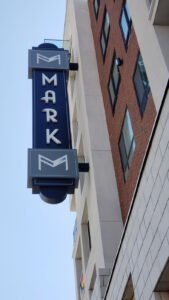
Since the early 2000s, Riverside has sought and encouraged more mixed-use and higher-density residential developments within the downtown core, specifically on portions of Market Street and along the Main Street pedestrian mall. Such mixed uses hearkens back to early Riverside (and America) where buildings downtown often had commercial (usually ground-floor) and residential components (upper floors). However, mixed uses began to lessen — even disappear — particularly when cities began employing stricter zoning in the 1920s and 1930s. And even more so when America began to significantly spread out into the suburbs, which accelerated greatly during the Post War years following WWII (spurred in part by the developing freeway system, the GI Bill, and VA/FHA loans).
Yet, over the past quarter century, many American downtowns have been revitalized, in part, by bringing back such mixed uses, which has also helped add some balance — and choices — into the residential market, especially in suburban-oriented places like Inland Southern California.
After a bit of fits and starts, several mixed-use and/or higher-density residential projects have been completed over the past 15-plus years within downtown Riverside — with at least one more in development and the possibility of a few more down the road. We take a quick look at the completed projects.
THE MARK (2023)
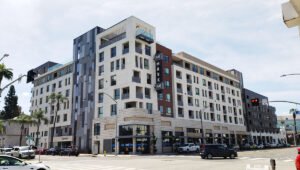
Built by Century City-based Regional Properties, LLC, and named for company founder/owner and long-time Riverside developer (the late Mark Rubin), the four- to seven-story, 410,000 square foot development consists of 165 residential units, 20,000 square feet of commercial space, and three levels of secured underground parking. The Mark is located on the east side of Market Street between Sixth Street and Mission Inn Avenue and consists of studio, one, two, and three-bedroom units ranging in size between 515 and 1,341 square feet. According to its website, some of the resident amenities include spa/pool deck, outdoor lounging with BBQs, roof top viewing deck, fitness center/lounge, sports lounge, game room, secure/refrigerated parcel lockers, bike storage room, resident storage, co-working space, and EV charging stations. Inside the units are full-size washer/dryer and stainless steel, energy-efficient appliances.
Construction started in late 2018 and was completed in early 2023, slowed in part due to import tariffs/supply chain complications and the Covid-19 pandemic. A nice aspect of The Mark is the incorporation of the facade from the historic Stalder Building into the project (with less massing in general, particularly immediately behind the facade). Another pleasant nod to Riverside history is the use of red brick for the potion above the facade where Riverside’s first official fire station once stood. Also present are homages to the former second-story hay-lift for the old fire station. Portions of the unbuilt Villaggio and Fox Plaza projects had been previously proposed for the site. (Sources: Riverside Press-Enterprise: PE-20020328, PE-20020728, PE-20050318, PE-20060419, PE-20150709, PE-20210223, PE-20220907, PE-20230226; The Mark, RaincrossSquare.com)
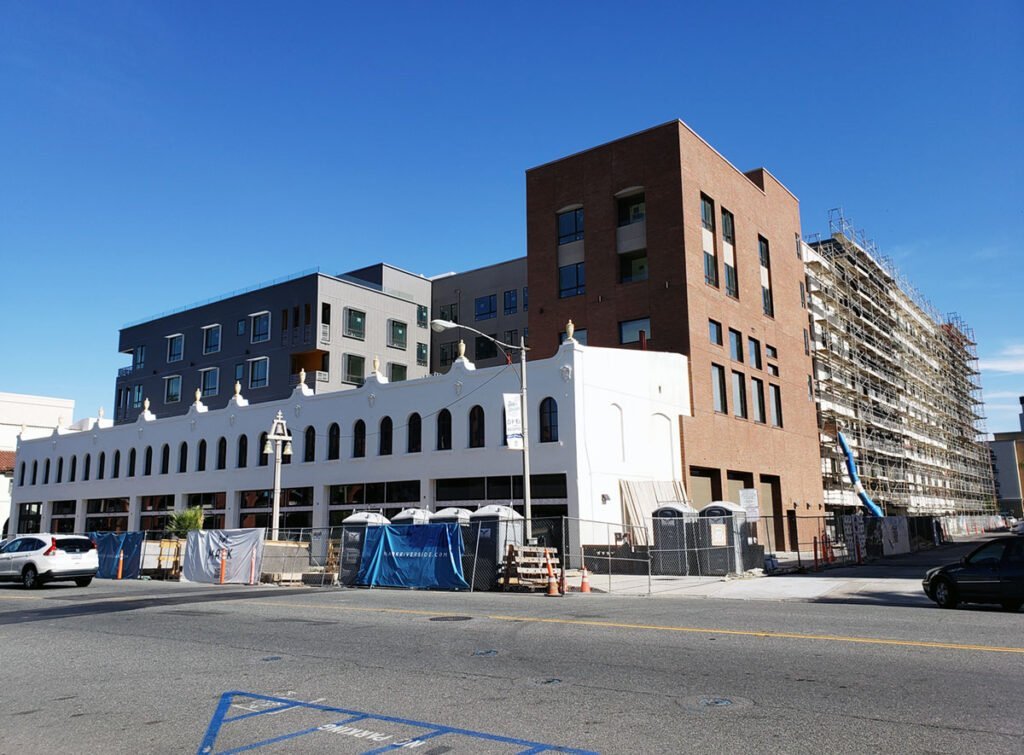
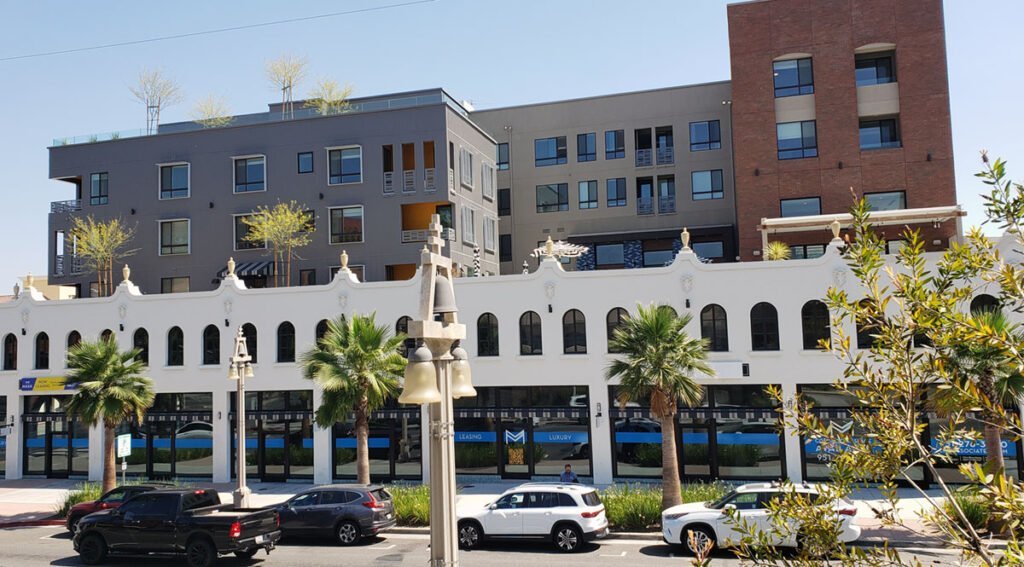

MAIN+NINE (2019)
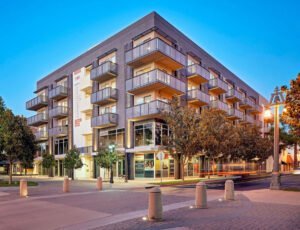
Another mixed-use project is the Main+Nine development near City Hall. Like the Imperial Hardware Lofts (see below), it too was developed by Ratkovich Properties as well as designed by DesignArc of Los Angeles. It is also located on the Main Street pedestrian mall — exactly one block south of its much larger sibling property (IHL). Smaller in scope and with a much smaller footprint, Main+Nine places residences at the southern end of the pedestrian mall. The five-story building contains 36 boutique, one- and two-bedroom apartment lofts over ground-floor commercial space (currently filled by Arcade Coffee Roasters). According to its website, some of the amenities include reserved parking, package lockers, top level outdoor lounging deck with TV, fire pit, food prep area, grilling stations, and outdoor dining. Inside the units are full-size washer/dryer and stainless steel, energy-efficient appliances.
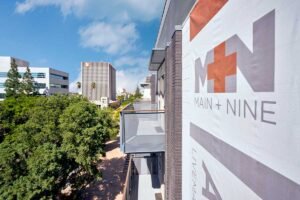
Construction was completed in Summer of 2019. The site — northeast corner of Ninth and Main streets — is the location of the former Reynold’s department store (1900), which later became Montgomery Ward (beginning in 1934), and still later Pic ‘N Save (1966) until sometime in the 1970s. The then-vacant building was demolished around February 1980, with the site used as a small parking lot until Main+Nine. (Sources: Riverside Press-Enterprise: RE-19340426, RE-19341109, RP-19660626, PE-19790520, PE-19800220, PE-20180818; “Riverside’s Invisible Past” (Joan Hall), Ratkovich Properties, City of Riverside)
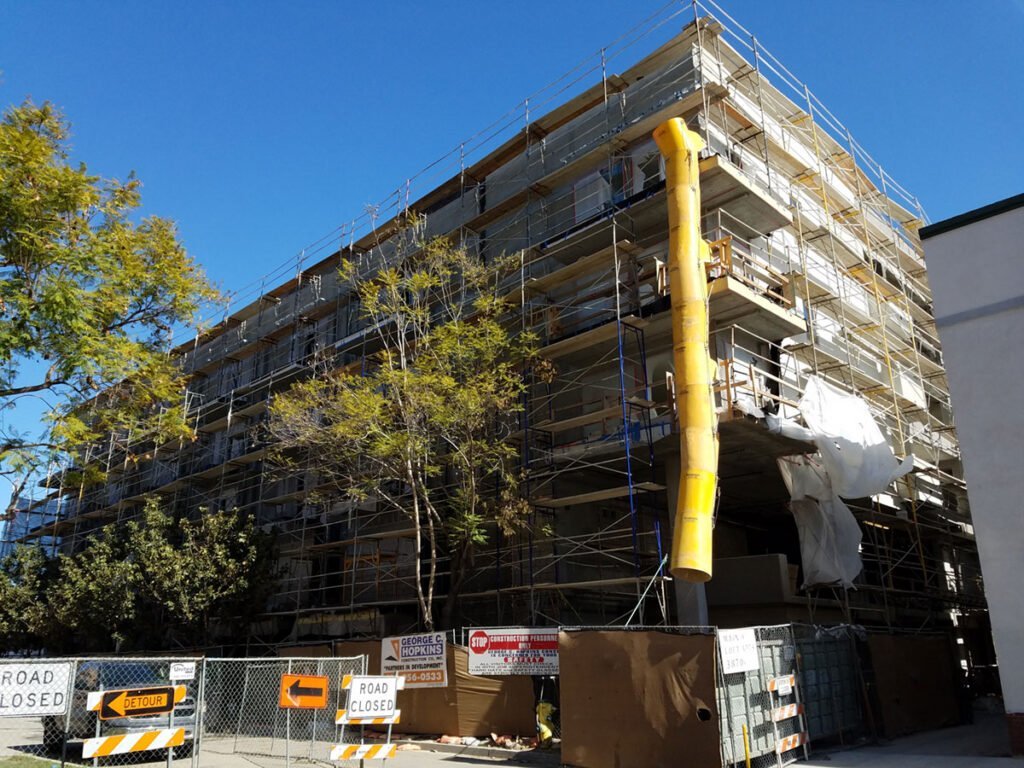
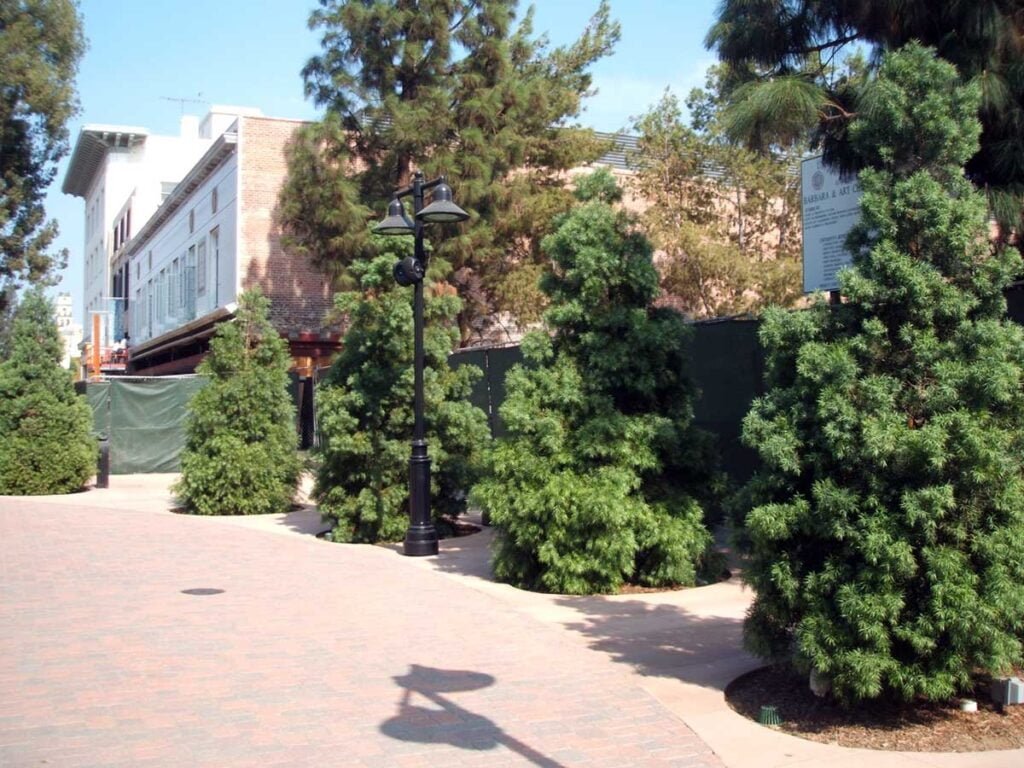
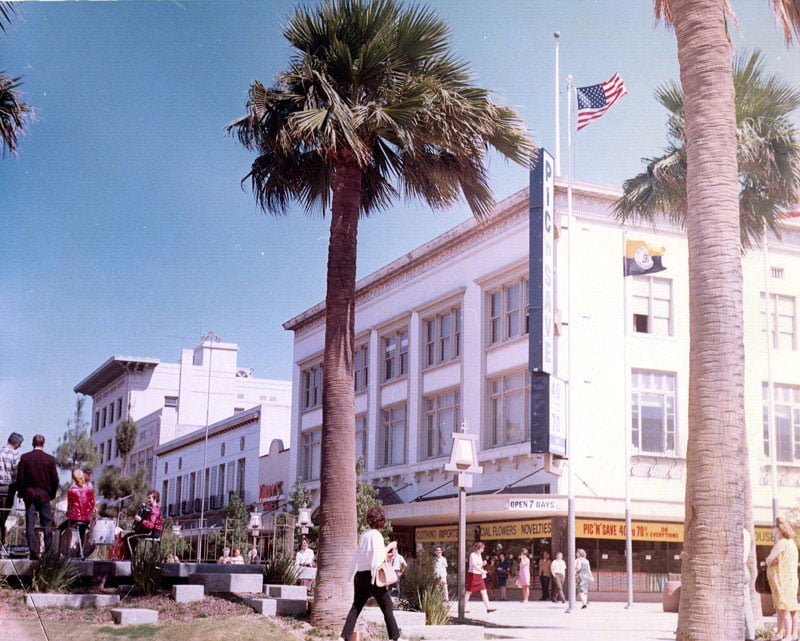
IMPERIAL HARDWARE LOFTS (2018)
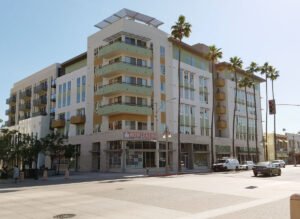
Opening around the time that construction began on The Mark, the Imperial Hardware Lofts was the first truly, large-scale mixed-use development in downtown Riverside. Developed by Irvine-based Ratkovich Properties (who also did Main+Nine — see above) and also designed by DesignARC of Los Angeles, the six-story building is located on the downtown pedestrian mall at the northeast corner of University Avenue and Main Street. It has 91 units consisting of studio, one, and two bedrooms, 9,000 square feet of commercial space, and two levels of secured parking (with one level underground). According to its website, some of the amenities include fully-equipped fitness center, pool/spa/sun deck with fire pits and grilling stations, indoor outdoor lounge/gaming/kitchen area, bike storage room, secure parcel room, and roof top sky lounge area and dog walk. Units contain full-size washer/dryer and stainless steel, energy-efficient appliances.
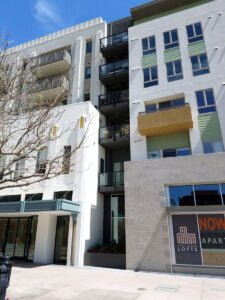
Construction began in October 2016 and was completed in August 2018. Like The Mark, Imperial Hardware Lofts also saved and incorporated a historic facade into the project. Built partly on the site of the former Franzen’s/Westbrook’s/Imperial hardware stores — whose collective history dates back to circa 1900 — the project kept the 1930s-era California Deco-Moderne facade of Westbrook’s, which had been hidden behind Imperial Hardware’s circa 1964 Mid Century-styled false front until June 2007. The remainder of the site was once the location of the stately Evans Building, which stood on the northeast corner of University Avenue (then Eighth Street) and Main Street from 1892 until being demolished in 1964, at which time the corner served as a small parking lot until the building of Imperial Hardware Lofts. (Sources: Riverside Press-Enterprise: PE-20140730, PE-20180818, PE-20190119; InlandEmpire.us, Ratkovich Properties, City of Riverside, “Riverside’s Invisible Past” (Joan Hall), “Henry L. A. Jekel: Architect of Eastern Skyscrapers and the California Style, 1895-1950” (H. Vincent Moses & Catherine Whitmore), RaincrossSquare.com)
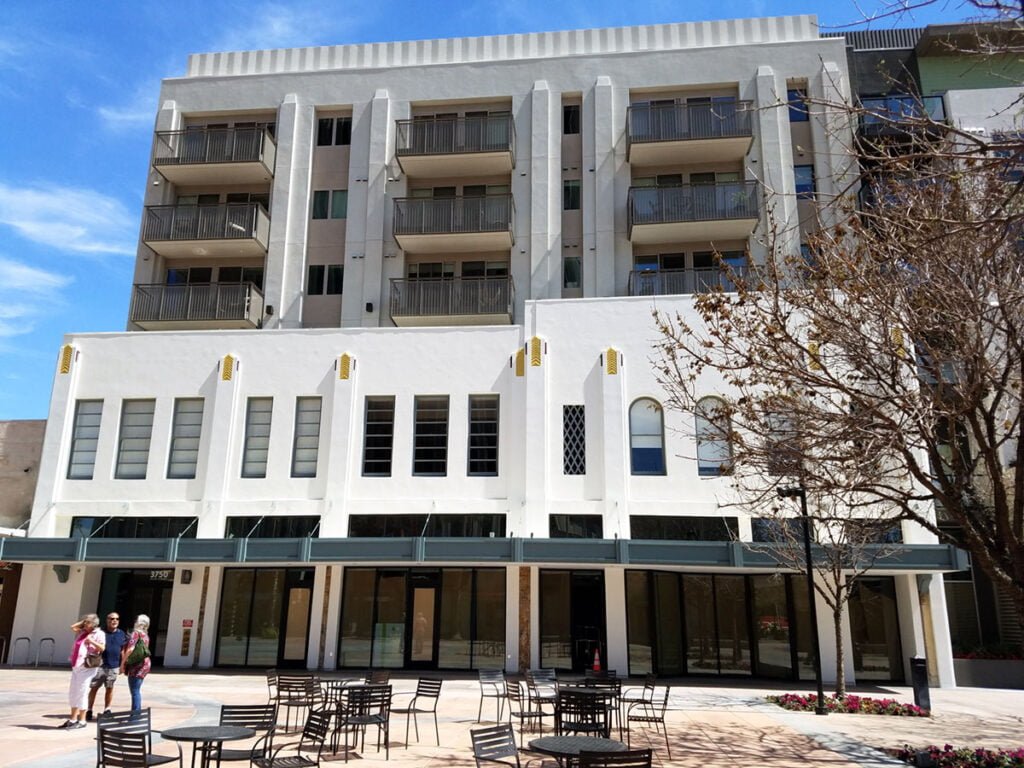


M SOLE’ (2008)

The last of the current batch of mixed-use developments downtown is actually the first of the bunch — albeit, a scaled-back plan. What originally was to be a two phase, mixed-use development on two nearby blocks along the west side of Market (between First and Third streets) — and consisting of 114 units (104 condos, 10 live/work) — ended up comprising only the first phase of 10 live/work units. Dubbed m Sole’ (aka m sole’), the project was developed by Alan Mruvka — founder of E! Entertainment cable channel — who was also behind the proposed Villaggio project, part of which was to be on the site where The Mark currently stands.
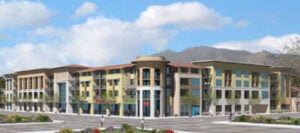
Proposed in May 2006, m Sole’s first phase consisted of 10, three-story live/work units located on the northwest corner of Third and Market streets. The units contain between 1,600 and 1,850 square feet with between 178 to 606 square feet as office space on the ground level. Each unit also has a one- or two-car garage. Phase Two of m Sole’ for the full block bounded by Market, Second, Fairmount, and First streets did not get beyond the proposal and approval stages. The project was to include a pool, clubhouse, wine cellar, fitness center, meditation garden, and 109 units (91 condos, 18 live/work units — a moderate change from when first proposed). The two- and four-story structure was to wrap around a 302-space parking structure. Also to be included was about 7,000 square feet of commercial space. The project went through a few design changes, the last one in late 2008 at which time it was downsized to 48 apartments, but with a larger commercial component that was reported to be a Fresh & Easy grocery store. The project faded away and the property reverted to the lender in late 2009. Standing on this block today is the Centerpointe at Market apartment development (see below). (Sources: Riverside Press-Enterprise: PE-20060520, PE-20060804, PE-20080713, PE-20081221, PE-20091217; m Sole’, RaincrossSquare.com)
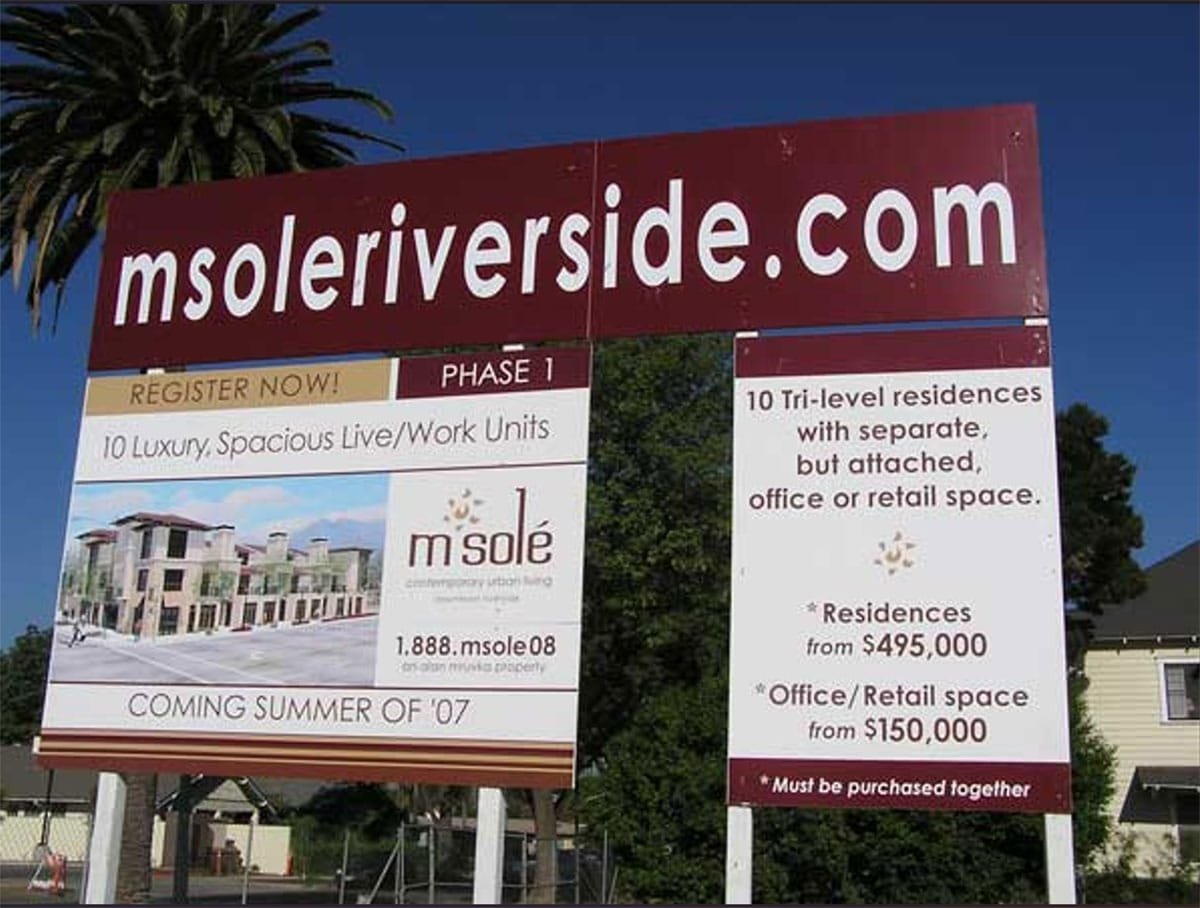
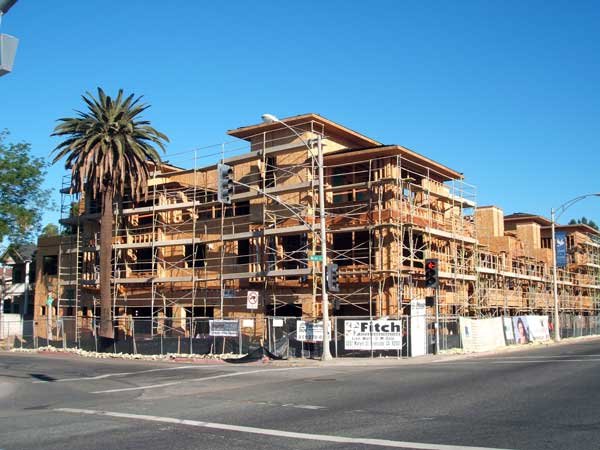
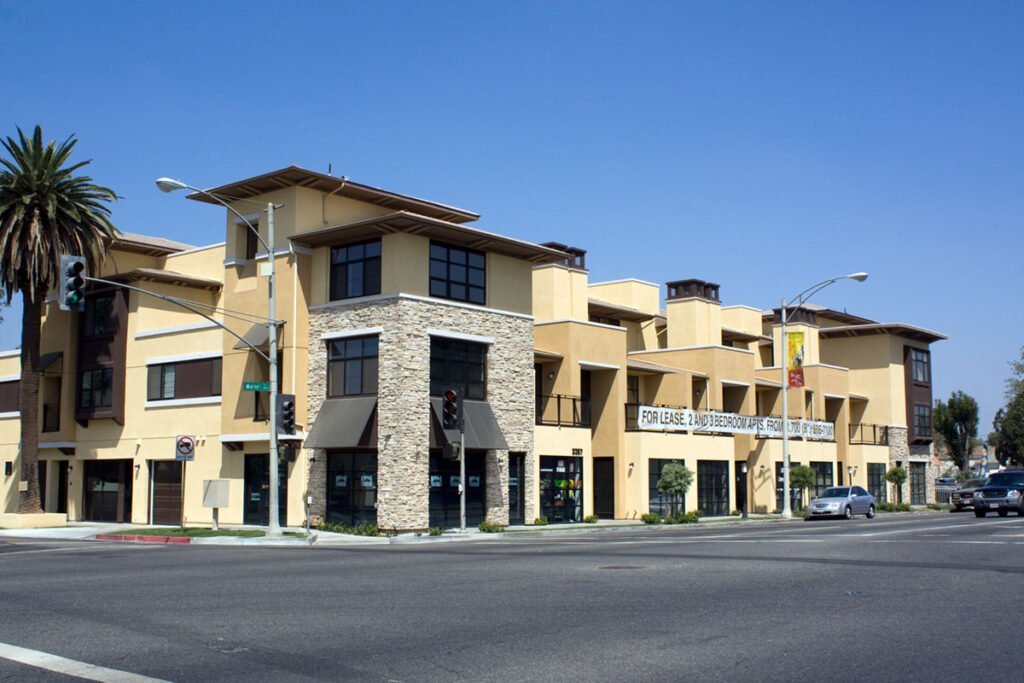
OTHER PROJECTS
At least six other residential projects have come to fruition during this time as well, with two early in the timeline and the remainder since 2019.
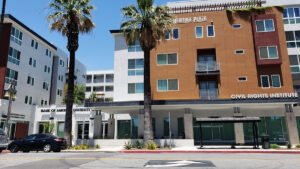
Mission Heritage Plaza (2022) — Among the recent mixed-use and residential developments downtown is the unique Mission Heritage Plaza. Situated along Mission Inn Avenue at Fairmount Street (across from Riverside Public Library’s main branch), the five-story project includes 72 affordable units (25 of which are for veterans). But its centerpiece is the 3,500 square-foot Civil Rights Institute of Inland Southern California. The Institute is part museum and part research/documentation center (with digital archives and recording capabilities). It also includes a Civil Rights Walk of Fame as well as the offices for the Fair Housing Council of Riverside County, which was previously located on the site within an odd, single-story office that had been built — likely sometime in the 1960s or 1970s — directly in front of an older two-story residence. Completed in October 2022, Mission Heritage Plaza won the “Multi-Family Development of the Year” award at the 2022 “Housing Within Reach” annual ceremony at the Southern California Association of Non-Profit Housing conference. The award is given to the most outstanding overall development. The project was designed by Pasadena-based Practice (formerly Gonzalez Goodale Architects) and developed by San Diego-based non-profit, Wakeland Housing & Development Corporation, who also developed Home Front at Camp Anza (2016; on Picker Street in Arlanza), and La Entrada (2024; on Seventh Street in the Eastside). (Sources: Riverside Press-Enterprise: PE-20171024, PE-20180307, PE-20201023, PE-20210217, PE-20221016, PE-20230320; Wakeland Housing & Development Corporation)
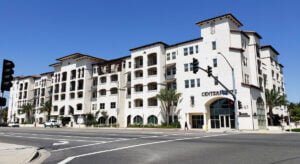
Centerpointe at Market (2021) — Bounded by Market, Second, Fairmount, and First streets, the five-story Centerpointe project consists of 125 units (42 one-bedroom, 76 two-bedroom, 7 three-bedroom) on the front half of the block (Market Street) with a three-level parking garage on the back half (Fairmount Street). The site is the former location of the proposed second phase for the m Sole’ mixed-use project that faded away in late 2009. According to its website, amenities at Centerpointe include a fitness center and yoga room, resort-style pool and spa, outdoor BBQs and picnic areas, secure package room with lockers, resident lounge, and business center. Inside units contain stainless steel appliances and full-size washer dryer. The project was developed by Zion Enterprises of San Clemente/Laguna Niguel. Leasing of the units began in late 2021. (Sources: Riverside Press-Enterprise: PE-20230320; City of Riverside, Centerpointe at Market, Zion Enterprises)

Circa on Mission (2020) — Another unique project among the various developments is Circa on Mission — a small collection of 13 luxury town homes located on the northwest corner of Mission Inn Avenue and Chestnut Street. The two-story town homes include three bedrooms, 2.5 baths, small fenced-in patio w/ yard, and two-car garages. The project was completed in April 2020 and was built by CityMark Development of San Diego, a company that is no stranger to Riverside as they had also been a potential developer of the site where The Mark currently stands. The slightly more than half-acre parcel was a former redevelopment site that previously included the Victoria convenience/liquor store. It was also mentioned in early 2016 as one of the potential sites for the relocated downtown library that ended up nearby across Mission Inn Avenue. (Sources: Riverside Press-Enterprise: PE-20170101; CityMark Development)

Mission Lofts (2019) — Although situated a few blocks from the downtown core on the other side of the 91 Freeway, the Mission Lofts project is located in an area once dominated by the citrus industry: rail lines, packinghouses/warehouses, loading platforms, and stations. In fact, still standing nearby are the former passenger stations for both Santa Fe and Union Pacific railways. Nearby are the Metrolink station and recently-built Vine Street Mobility Hub for Riverside Transit Agency (RTA). The four-story Mission Lofts development — with corrugated metal exteriors meant to resemble shipping containers and evoke Riverside’s citrus heritage — includes 212 units (52 studio, 77 one-bedroom, and 83 two-bedroom). Built by Newport Beach-based Realm Real Estate, the project was completed in mid-2019. (Sources: Riverside Press-Enterprise: PE-20190426; Mission Lofts, Realm Real Estate)
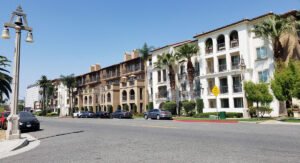
Raincross Promenade (2010) — A stone’s throw from Mission Village is Mark Rubin’s second of three downtown residential projects. Situated on the full block of Market, Second, Main, and Third streets, the four-story development consists of 141 units surrounding a parking structure and with a community pool. Newport Beach architect Newman Garrison was the designer. This was the first large-scale, multi-family development of those built since the early 2000s. Originally planned for two full blocks (reaching to First Street) and with up to 275 for-purchase condos, the project was halved to 141 for-lease units due to variables encountered within the housing market (namely the flood of foreclosures following the 2008 housing market crash). It was completed in July 2010 and remains a integral part of the downtown residential scene. (Of note, Second Street between Main and Market was vacated as part of the original project encompassing two full blocks.) (Sources: Riverside Press-Enterprise: PE-20070408, PE-20070815, PE-20070920, PE-20071019, PE-20080713, PE-20100719, PE-20100831)
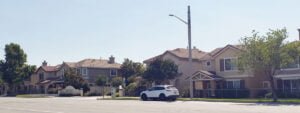
Mission Village (2003) — This was actually the first of all the developments and was completed in August 2003. Though neither a mixed-use nor multi-family project, the development is a compact collection of single-family homes sharing a pool within a gated community. It was a significant development on account that it was reportedly the first large-scale development of new residences in the downtown area in about 50 years. Situated on 6 acres near First and Market streets, the project includes 46 two-story, three-bedroom homes ranging in size from 1,450 to 1,870 square feet. Each home also sports an attached, two-car garage. It was developed by Mark Rubin, who also developed The Mark (see above) and Raincross Promenade (see above). (Sources: Riverside Press-Enterprise: PE-20020609, PE-20020728, PE-20020729, PE-20030727, PE-20030828)
It has taken nearly 20 years to get to this point, which considering the scope and complexities of such developments — not to mention market forces — is not all that long. Although much larger and more urban than Riverside, downtown San Diego began working at increasing mixed-use and residential options in the mid- to late-1970s via the city’s former redevelopment arm known as Centre City Development Corporation (later CivicSD). Though state-regulated redevelopment is no more, encouraging and planning for varied residential uses in San Diego remains an on-going process. One aspect that San Diego implemented early on — and that Riverside has only studied thus far — was a single-line, fixed-rail trolley that has since been expanded into a moderate-sized, multi-line light rail system for portions of Greater San Diego.
Regardless, in comparison to its Inland neighbors — plus considering the Inland region’s dominance of and reliance upon suburban style development — Riverside has been relatively successful the past decade-plus in adding mixed-uses back into its overall development mixture for downtown — and doing so without losing too much historical character. And as easy-to-develop land becomes even more scarce and environmental factors conceivably become more challenging in the coming decades, inclusion of more efficient, higher-use development is likely to increase.
The single-family house that symbolizes life in the Inland Empire will be alive and well 25 years from now.
… But, in many cases, the stand-alone dwelling of the future won’t resemble the house with the big backyard common today in Riverside County, San Bernardino County and eastern Los Angeles County.
“Housing is evolving and there will be surprises,” said developer Randall Lewis, executive vice president of Upland-based Lewis Management Corp.
Look for houses to be more dense, more vertical, more energy efficient — many will produce as much electricity as they consume — and located near stores, Lewis said.
Look also for a higher proportion of housing to be apartments, condominiums and town homes, some of which will be hard to tell apart from the new single-family home.
“The lines between multifamily and single family will blur,” Lewis said.
Riverside Press-Enterprise – March 20, 2023
The trick will be to ease these probable future developments into the older downtown cores and potential transit centers without too much loss of cultural fabric and historical character (and using adaptive reuse whenever possible/viable). Progress with preservation. Such is not mutually exclusive. Both are possible together. Just take a look at Pasadena, Long Beach, and San Diego.
Related
- Riverside Press-Enterprise – In 25 years, housing will look different in Inland Empire (March 23, 2023)
Sources (all): Riverside Press-Enterprise (RE-19340426, RE-19341109, RP-19660626, PE-19790520, PE-19800220, PE-20020328, PE-20020609, PE-20020728, PE-20020729, PE-20030727, PE-20030828, PE-20050318, PE-20050506, PE-20050817, PE-20051217, PE-20060419, PE-20060520, PE-20060804, PE-20070408, PE-20070714, PE-20070815, PE-20070916, PE-20070920, PE-20071019, PE-20080523, PE-20080713, PE-20081221, PE-20090612, PE-20091217, PE-20100304, PE-20100719, PE-20100831, PE-20120419, PE-20140307, PE-20140730, PE-20150709, PE-20170101, PE-20171024, PE-20180307, PE-20180818, PE-20190119, PE-20190426, PE-20201023, PE-20210217, PE-20210223, PE-20220907, PE-20221016, PE-20230226, PE-20230320), InlandEmpire.us, Ratkovich Properties, Imperial Hardware Lofts, Main+Nine, The Mark, Centerpointe at Market, m Sole’, Mission Lofts, Realm Real Estate, CityMark Development, Wakeland Housing & Development Corporation, “Riverside’s Invisible Past” (Joan Hall), “Henry L. A. Jekel: Architect of Eastern Skyscrapers and the California Style, 1895-1950” (H. Vincent Moses & Catherine Whitmore), RaincrossSquare.com; NOTE: Dates for some online versions of newspaper articles cited may not match their archival source date.

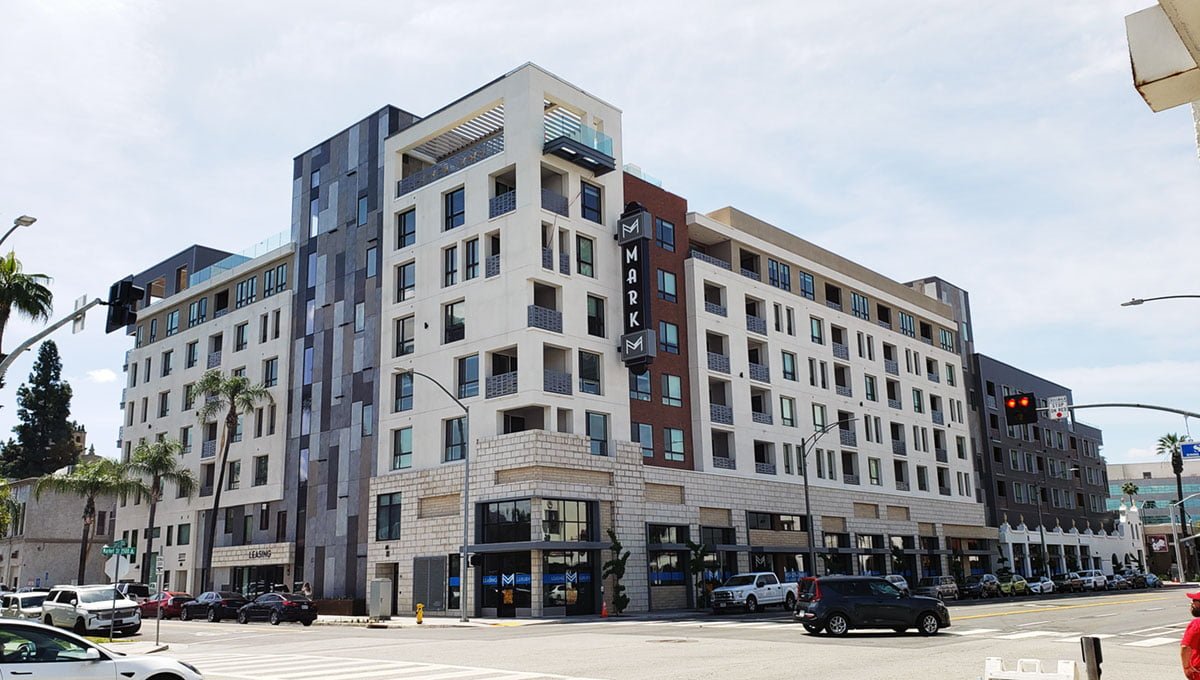
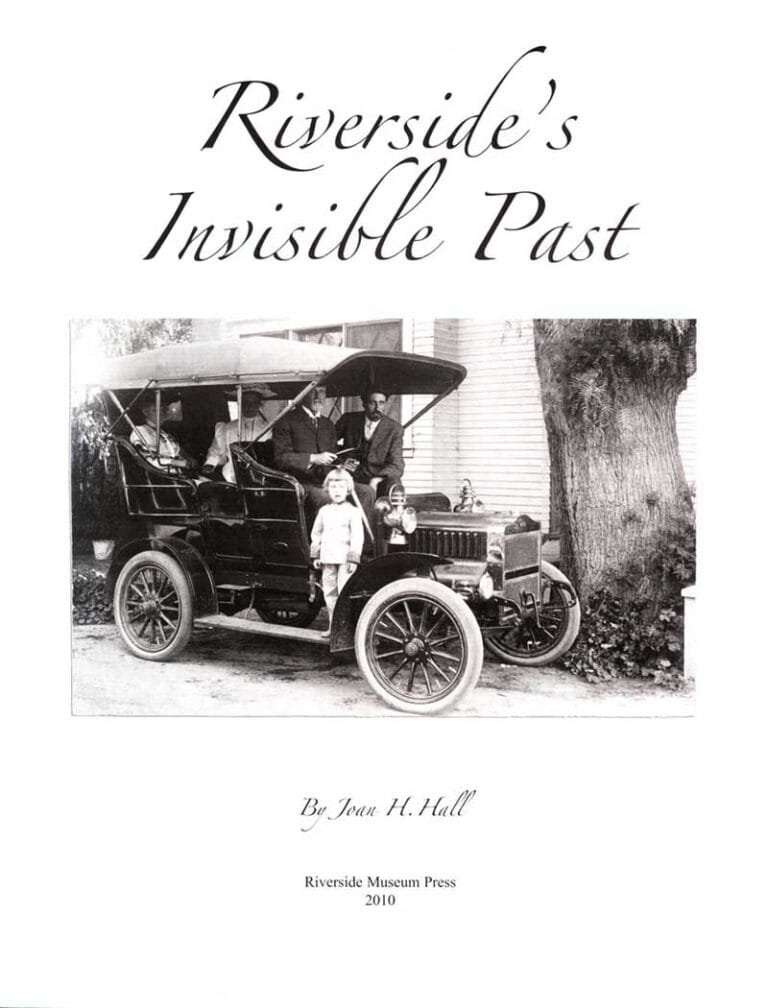
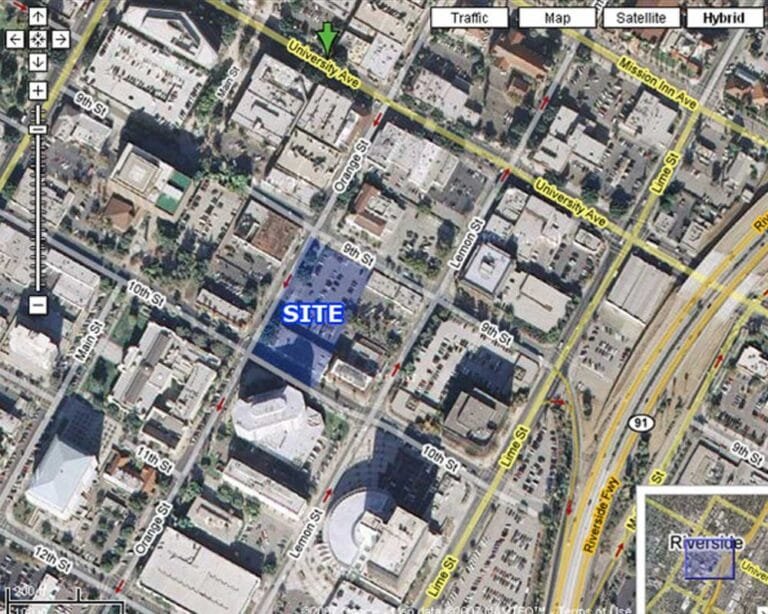
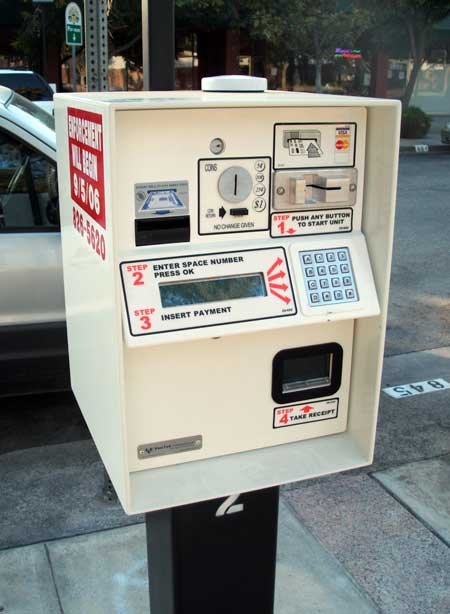
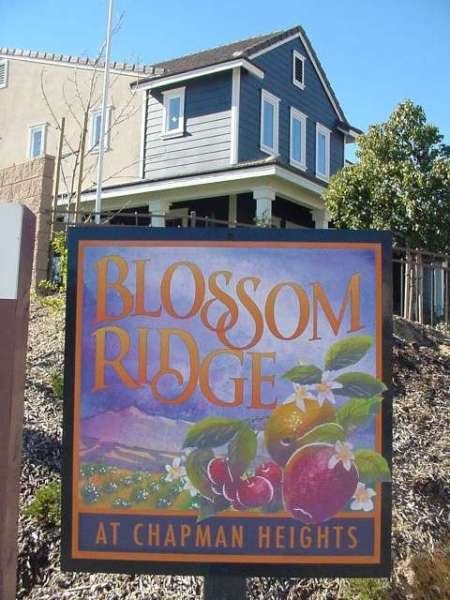
So glad this website is back up. Looking forward to seeing more of the archive photo galleries be reuploaded. Thank you for doing this